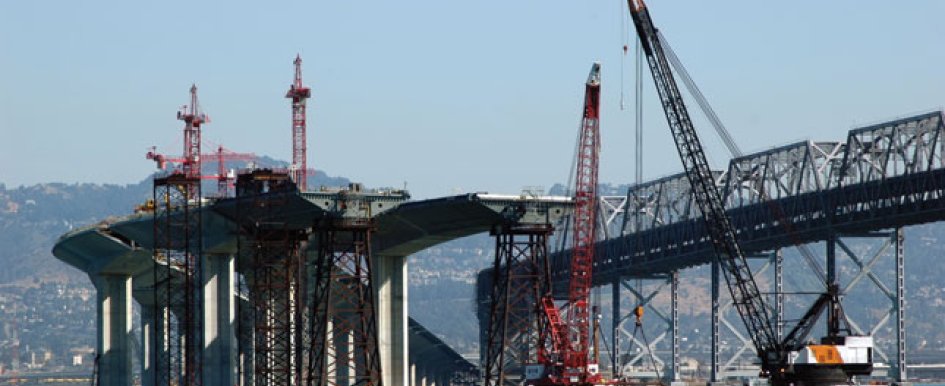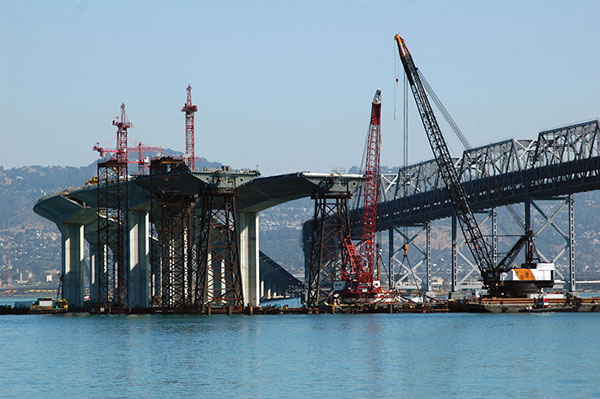
Infrastructure in the U.S. is deteriorating, and though maintenance is improving, the nation is far behind an appropriate level of upkeep. In the “2013 Report Card for America’s Infrastructure,” released in March by the American Society of Civil Engineers (ASCE), the country earned a D+, up from the D earned in the previous report, which was released in 2009.
The problems with American infrastructure that the ASCE found were numerous and at times alarming. Highlights of the report include the following:
- The average age of the country’s 84,000 dams is 52 years.
- Despite the $141 billion in flood damages that were prevented by levees in 2011, $100 billion is required to repair the 100,000 miles of levees in the U.S. Additionally, the country has no levee safety program.
- Airport congestion, according to the Federal Aviation Administration (FAA), cost the U.S. almost $2.2 billion in 2012. This cost is expected to rise to $34 billion by 2020 and $63 billion by 2040.
- The country’s infrastructure requires a $3.6 trillion investment by 2020—$1.6 trillion more than is currently budgeted.
- Much of the inland waterways system has not been updated since the 1950s, despite carrying the equivalent of 51 million truck trips per year.
- The backlog of inland waterways system projects extends to the year 2090.
- Road congestion costs the economy an estimated $101 billion per year in wasted time and fuel.

Something needs to be done, but only incremental progress is being made. “I think one of the reasons it’s gotten so bad is because we are so used to having really good infrastructure,” says Marcia Hale, president of Building America’s Future (BAF). “Most of us grew up with the interstate highway system, and then we’ve seen enormous strides in technology that help with infrastructure. But, at some point we have to replenish what we were given and add additional transit options, and we’re not doing that at a fast enough speed.”
As the ASCE report notes, the progress being made is negligible compared to what needs to be done. “There is certainly work being done,” Hale says, “but we need to quadruple the effort. There’s just an enormous amount of work that needs to be done across the spectrum.”
These infrastructural deficiencies place contractors in a favorable position. On one hand, a large amount of work needs to be done. However, the public capital needed to fund that work is largely not available. Andy Howard, construction and government contract litigation expert and partner at Alston & Bird LLP, sees the predicament balancing in favor of contractors for now. “In my experience,” he says, “it seems like there’s been an uptick in the number of opportunities available. We have seen some international contracting companies moving into the U.S., which they see as a growth market. Firms who weren’t players before are coming in and pursuing large infrastructure improvement projects.”
Some commentators in the construction industry have suggested that public-private partnerships (P3s)—projects that are commissioned by the government but fulfilled through varying types of partnerships with private-sector entities—will be key to overcoming the government’s current inability to fund many of the projects that need to be undertaken. The argument is that, while the government struggles to fund infrastructure projects, the manpower and capital of the private sector can be employed to perform the necessary work.
However, some important caveats must not be ignored. Hale says that BAF is “very much in favor” of P3s, but she says that they are plausible only for certain projects. The problem is that P3s do not inherently solve the funding issue. “The thing about a public-private partnership,” she says, “is that if you’re putting private funds or investment funds into a project, at some point those funds need to be paid back to the investor. So, they have to be projects that have some type of revenue stream attached to them.”
Steve Fleck, P3 expert and vice president of the professional consulting firm Stantec, is also in favor of P3s. He argues that the primary benefit of such partnerships is not that they allow access to funds that aren’t otherwise available but that they provide efficiency.
“What you get with a public-private partnership isn’t so much the mobilization of private capital that everyone tends to focus on,” Fleck says. “It’s the improved efficiency and risk transfer that occurs from the public sector owner to the private sector partner. What the public gets is much more cost-certain and time-certain projects that have some real teeth around the operations and maintenance areas over the lifetime of the concession.”
He elaborates, “Another way of looking at it is if there is a bust in a proponent’s estimate, the first people that feel the bust are the equity participants. They lose their equity. In a traditional implementation, that equity comes out of the public sector purse. Of course the private sector is highly motivated to prevent that from happening.”
Still, some warn that P3s may be more problematic than practical. Howard argues that in many instances, public agencies lack the flexibility needed to make such projects efficient. “The problem,” he says, “is that state, local and federal agencies are rules-oriented organizations, and the P3 model is outside most of those rules.” The problem lies not in the P3 concept but in the U.S.’s public organizations. Howard points out that other countries have seen smoother implementation of the practice: “While P3 has been very successful in other parts of the world, the United States lags substantially far behind. A lot of things have to happen before P3 is going to be a viable, widespread option for at least a portion of the infrastructure issues we’re dealing with.”
Howard says those who are looking to position themselves for infrastructure work need to first research the public sector. “The contractor compliance obligations that apply to virtually all government contracts at all levels—federal, state and local—are very different from what you would encounter in a purely commercial construction transaction,” he says. “There are all sorts of reporting obligations, compliance obligations and procurement restrictions.” Howard recommends that contractors performing work in the public arena for the first time consider partnering with other contractors who have experience with such work. With this approach, the contractor’s first foray into public work becomes a learning experience. Then, the contractor is prepared to engage in this type of work with knowledge of the issues specifically relevant to public work as well as how to handle those issues.
Regardless of when funding arrives, U.S. infrastructure will have to be repaired at some point. The consequences of failing to do so are too great to ignore. While the P3 concept is viewed as a potential way to address the problem, contractors must understand its nuances and potential problems before trying to embark on such projects. Public-private partnerships have inefficiencies that have not been addressed, and, as Hale and Fleck point out, their primary benefits are not what many contractors understand them to be.
